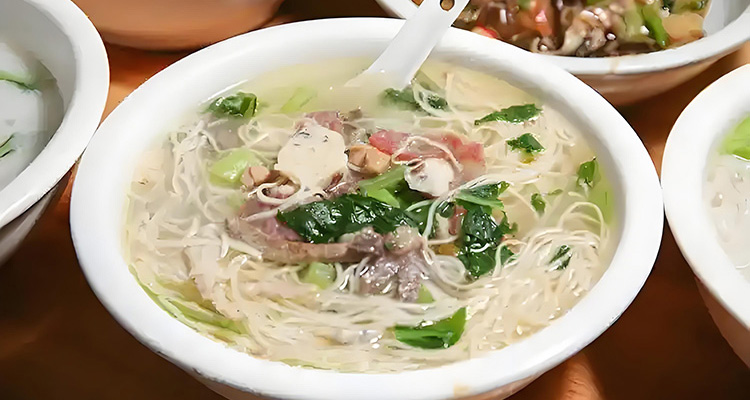Hainan Yimian Soup: Island Egg Noodle Delight
In China’s southernmost island of Hainan, beyond palm-fringed beaches and blue skies, you’ll find a warm, comforting bowl that locals often reach for at breakfast or lunch: Hainan Yimian Soup. This humble noodle soup blends Southeast Asian (Nanyang) heritage with local island ingredients. A clear, slow-simmered pork bone broth meets yimian—special egg noodles that were steamed, fried, and dried—giving them a springy yet slightly crisp texture even after soaking in soup. For travelers, tasting an authentic bowl is not just a culinary delight but a quick, authentic way to experience Hainan life.
1.Origins: Nanyang Influence Meets Island Taste
Yimian’s story is tied to Hainan’s history as an overseas Chinese homeland. The noodle’s technique and name are believed to have roots in southeast Asian Chinese communities. Returning Hainanese migrants adapted the fried egg noodle into a local soup, combining the Nanyang respect for aromatic broths with Hainan’s preference for light, fresh flavors. The result is a dish that balances nostalgia and local innovation.
2.Cultural Significance: A Comforting Local Ritual
In Hainan, Yimian Soup is more than a dish—it’s part of the daily rhythm. Similar to Wuhan’s hot dry noodles or Chongqing’s spicy noodles, Yimian Soup is a regional comfort food that appears on many breakfast tables. Office workers, students, and elders all savor a bowl to start the day. For visitors, slipping into a busy neighborhood stall and ordering a bowl is one of the fastest ways to blend into local life.

3.Key Ingredients: Simple but Distinctive
- Soulful Broth: The broth is the foundation. Authentic Yimian Soup uses pork bones simmered for hours until the liquid becomes fragrant and slightly milky with collagen. It’s clear and clean-tasting—no heavy seasonings to mask the pork’s natural sweetness.
- Yimian Noodles: These egg noodles are special. After dough preparation, the noodles are steamed, fried, and dried into flat noodle cakes. That process gives them an eggy aroma plus a slightly crispy and springy bite that stands out in soup.
- Classic Toppings: Simplicity rules. Thin slices of lean pork, a few springy prawns, a handful of greens (lettuce or local leafy greens), and a halved marinated egg or a soft-poached egg. When the yolk breaks, it enriches the broth.
4.How It’s Made: Where the Craft Shows
- Simmer the Broth: Blanch pork bones, then simmer on low for several hours with ginger and scallions until the stock turns fragrant and slightly opaque. Skim off excess oil to keep it clean.
- Prepare Toppings: Slice lean pork and marinate briefly if desired. Clean prawns and wash vegetables.
- Cook the Noodles: Drop the pre-fried, dried yimian noodle cake into rapidly boiling water for about a minute—just long enough to loosen and soften without losing texture.
- Assemble: Place noodles in a bowl, add blanched pork, prawns, and greens. Pour the hot broth over to cook the toppings just right.
- Finish: Top with a halved marinated egg or poached egg and a sprinkle of scallion or cilantro.

5.Taste Profile: A Layered, Comforting Experience
Start with a sip of the broth: clean, pork-sweet, and warming. Then lift the golden yimian—smooth and springy with a faint crispness. The lean pork adds savory body, prawns bring a touch of ocean sweetness, and the greens refresh the palate. Puncturing the egg yolk creates a richer, silkier soup that ties all textures together.

6.How to Eat It: Local Tips
- First taste the broth plain. Hainanites recommend enjoying the original flavor before adding condiments.
- If you like heat, try a small dip of the local yellow lantern chili sauce—add sparingly to preserve the broth’s subtlety.
- Pair with “zhègu yè” tea (local quail-bean tea) to refresh your palate.
7.Where to Find the Best Yimian Soup
Skip upscale tourist restaurants—authentic Yimian typically hides in neighborhood breakfast shops, old-style tea houses, and small street stalls. The busiest hours are 7:00–10:00 AM. Haikou, Wenchang, and Qionghai are reliable cities for finding beloved local shops. Ordering is simple: say “one bowl of Yimian soup” and indicate whether you want an egg.
Budget: A bowl usually costs RMB 10–20, making it an affordable and satisfying stop on your food itinerary.
8.Quick Home Version: Recreate the Island Flavor
- Broth shortcut: Use a high-quality pork stock cube or concentrate, boil with ginger and scallion.
- Noodles: Buy dried or fresh yimian (egg yimian) from Asian supermarkets.
- Assembly: Blanch proteins and vegetables, cook noodles about one minute, place in bowl, pour hot broth, add a poached egg.

9.Final Note: Taste Hainan’s Everyday Warmth
Hainan Yimian Soup is a small culinary landmark: unpretentious, flavorful, and steeped in local history. When you visit Hainan, duck into a steaming local shop, order Yimian, and let that clear pork broth and springy egg noodle tell you a story of island life. It’s one of the most authentic and heartwarming ways to experience Hainan culture.


